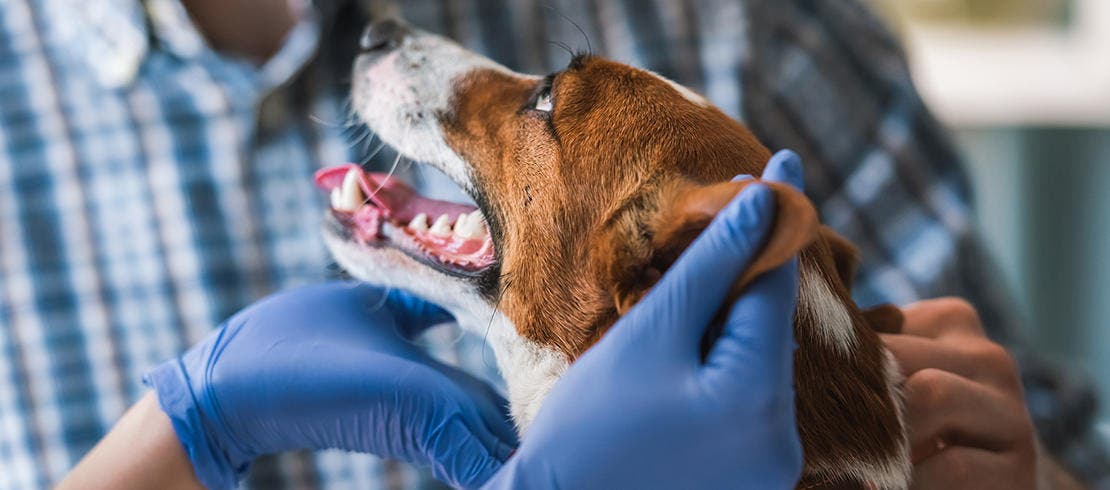Just like people, dogs can get Lyme disease too and it can cause serious health problems. It’s one of the most common diseases spread by ticks in the UK.
While not all tick bites will result in an infection, it’s best to act swiftly if you notice your dog has been bitten as if left untreated, Lyme disease can cause big problems.
What is Lyme disease?
There are several different species of tick common to the UK, but it’s the Ixodes ricinus species – also known as the sheep tick or castor bean tick – which is the main culprit behind the spread of Lyme disease.
The disease is caused by a bacteria called Borrelia burgdorferi. The bacteria are carried by Ixodes ticks that can transmit it to dogs and humans when they bite. Once inside the body, it travels around to different parts, such as the lymph nodes and joints, causing an inflammatory reaction, which can make us feel very unwell. Read on to find out the symptoms of Lyme disease in dogs, so you can spot it and treat it early.
How common is Lyme disease in dogs in the UK?
Ticks and tick-borne diseases are rising in the UK, thanks to climate change. The Government previously estimated that there are around 2,000 to 3,000 new human cases of Lyme Disease every year. However, new research has shown that cases of Lyme disease in people in the UK may be three times higher than previous estimates putting the number of incidences at over 7,000 per year1.
As pet ownership rises and tick numbers increase, pet owners and our dogs are at more risk than ever. It goes without saying, the more time your dog spends roaming the great outdoors, the higher the chance they may get bitten. All dogs of any size, shape and breed are at risk of Lyme disease.
How can dogs catch Lyme disease?
Ticks are very hard to spot as a hungry tick can be very small, but they grow during feeding when they fill with the blood of their host animal.
Ticks love to lurk in shady, moist places, either close to the ground or clinging to vegetation such as tall grasses, bushes and trees. The edges of woodlands are also a favourite habitat.
Here, ticks lie in wait for their host, usually climbing to the top of a blade of grass, waiting for an animal to brush past so they can latch on. When your dog is out and about, the tick then ambushes – it bites, hooking onto your pet’s skin with its strong mouthparts and will feed on your dog’s blood.
This is when an infected tick can pass on the bacteria that can cause Lyme disease.

What are the symptoms of Lyme disease in dogs?
Even if your dog has Lyme disease, you may not notice. Just one in ten affected dogs show any symptoms and when they do, it might be after a two to six-month incubation period.
Unlike humans, the clinical phases of the disease in dogs cannot be divided clearly into three stages but as the disease progresses an infected dog will show more symptoms.
Early stages following a tick bite
At this point symptoms can be very vague and often dogs can show no signs at all or any initial symptoms disappear after a few days. For this reason, often dog owners easily overlook this stage.
Symptoms include:
- Fatigue
- Fever
- Swollen lymph nodes near the site of the tick bite
- Lameness that shifts from one leg to another
Weeks to months after initial infection
Pet owners often first recognise lameness where the tick had latched on. But this lameness is often intermittent and may recur two to three weeks later in the same or a different limb and left untreated it can lead to chronic joint problems.
Symptoms include:
- Pain
- Swelling
- Lameness
At this stage, Lyme disease can become more serious, in some cases other clinical signs may be seen depending on where the bacteria localise in the body and the dog’s immune response to the bacteria, for example Lyme disease can cause kidney damage, although this has been mostly reported in the US. And although this is rare, Lyme disease can be fatal in dogs.
How is Lyme disease diagnosed in dogs?
If you suspect your dog might have Lyme disease or if they’ve been bitten by a tick and they’re not acting themselves, you should speak to your vet as soon as possible. The earlier it’s detected, the better!
During the appointment explain when the tick bite occurred (if known) and give a thorough history of any symptoms since it happened. Your vet will use this information to understand how likely it is that your dog might have the disease, the diagnostic testing for Lyme disease that may be necessary and which organs may be affected.
Definitive diagnosis of Lyme disease can be very difficult, and diagnosis is based on likely tick exposure, clinical signs, supportive diagnostic test results and response to treatment. Because of this, many cases are suspected as opposed to confirmed in dogs.
You vet may ask to perform one or more of the following tests:
- Blood and biochemistry tests - This looks for specific antibodies, which your dog’s immune system may produce if they have been infected by the bacteria that causes Lyme disease. Note that if your dog tests positive, it doesn’t always mean that they will have the disease or develop symptoms it simply indicates exposure to the bacteria and not the disease itself. But also, if the test is negative it doesn’t mean they haven’t got Lyme disease as it can take three to five weeks for antibodies to develop after infection.
Biochemistry tests are a form of blood test which will check your dog’s kidneys, liver and pancreas are functioning as they should.
Complete Blood Count (CBC)
This tests for any blood-related health conditions.
- Urine tests - Your vet will examine how the kidneys are working and tests will screen for urinary infections and other diseases.
- X-rays - If your dog is showing signs of painful or swollen, inflamed joints, an x-ray will allow the vet to assess any abnormalities.
How is Lyme disease in dogs treated?
So, your dog has been diagnosed with Lyme disease, what next? The treatment your vet recommends will be based on your dog’s symptoms, but often antibiotics, such as Doxycycline, are prescribed.
Luckily, if treatment is started in the early stages of the disease an improvement in lameness can be seen in as little as 24 to 48 hours. Do take care to follow the full course of medication, which can last four weeks (but sometimes longer), even if your dog’s symptoms disappear before the end of treatment. This is essential to make sure the bacterial infection has cleared completely. And make it a priority to attend regular check-ups as requested by your vet.

Sometimes antibiotics don’t completely get rid of the Lyme disease bacteria. This means that while symptoms might initially improve, your dog may become ill again later. If this happens, you should speak to your vet immediately.
Luckily, using the antibiotics as directed by your ve and taking the full course can help minimise this risk.
If your dog is in pain or suffering with lameness, then your vet may also give your dog painkillers to help them manage symptoms.
How can I prevent Lyme disease in my dog?
When it comes to Lyme disease in dogs, prevention is always better than cure. The good news is, we can help to avoid tick bites and a Lyme disease infection.
- Use a tick control product - These are medications that you can give your dog to kill ticks. They come in a wide variety of formats, from topical and oral formulas – that are usually given either once a month or once every three months – to medicated collars, which can last much longer.
Seresto Flea and Tick Control collar protects your dog or cat against fleas and ticks for seven to eight months in a single application. The collar kills fleas and repels and kills ticks without the need for them to bite your pet.2 It works by slowly releasing its active ingredients from its unique collar matrix in controlled, low doses giving long-lasting protection. Learn more about how flea and tick collars can make your life that much easier.
- Avoid areas with tall grass - Ticks love wooded areas and fields, so keep a watchful eye on your dog when walking through these areas.
- Take extra care to maintain your garden - Regularly mowing your garden to keep grass short and clear debris and dead leaves can help discourage ticks.

- Keep wildlife off your garden - Fences can help prevent deer and other tick-carrying creatures from wandering onto your property posing risk to your pet.

- Examine your dog and yourself after walkies - Look carefully over your pet for ticks after walks in woodland or grassy areas, paying special attention to the feet and between the toes, lips, eyes and ears (inside and out), around their groin and under their tail. A comb can help you do this so you can part the fur and more clearly see the skin and where the tick is attached. You’ll want to check yourself too, to make sure you’re not host to a new bloodsucking critter.

- Remove ticks as quick as possible - If you find a tick, remove it as quickly as you can using a special tick remover tool. Don’t try to use tweezers or your bare hands!
Learn more about the right way to remove a tick (and what to avoid).
- Monitor your pet for signs of Lyme disease - If your dog appears unwell, shows changes in behaviour or a decrease in appetite, then take them to your vet for a check-up.
Remember, ticks aren’t just a summer annoyance. They can be active during other parts of the year and even during mild winters, so be sure to protect your dog year-round.
Learn more information about keeping your dog tick-free.
Can you catch Lyme disease from your dog?
There’s no evidence that you can contract Lyme disease from your dog, but if you are bitten by a tick then you could be at risk. Pets can bring ticks into close contact with humans, carrying them into the house and garden. For this reason, it’s always best to use a tick control product for your dog protecting your pet, you and your household too.
Did you know…?
Lyme disease gets its name from the town where it was discovered in Lyme, Connecticut!
1.Cairns V, Wallenhorst C, Rietbrock S, et al. Incidence of Lyme disease in the UK: a population based cohort study BMJ Open 2019; 9: e025916
2. Information is regarding mode of action and is not intended to imply parasites can be completely stopped from biting.

